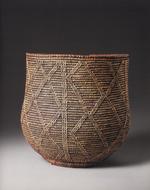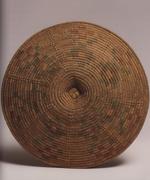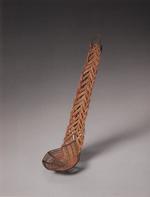
Closely-coiled grass and reed baskets are commonly made for a variety of purposes such as the storing of grain and other foodstuffs in the homestead, including liquids like milk and beer.
Many were decorated with intricately woven and embossed patterns. Baskets like these often formed part of the dowries brides brought to their new homes.
Different materials were used for different basket types, for example, coarse thatching grass in the making of large grain baskets. Sisal is sometimes employed for durable baskets like the Swazi titja (or sitja) that traditionally were given as gifts and are said to symbolize a long and productive life.

Basket makers generally coil and sew their baskets simultaneously, gradually ‘growing’ the structure until the desired shape and size has been achieved.
The materials used to make coiled baskets vary from place to place, and in the past often depended on function. Ilala palm fronds (hyphaene coriacea) commonly used to over-sew the baskets coiled from grass ropes (rhynchelytrum setifolium) in present-day KwaZulu-Natal have a waxy surface that makes this material ideal for weaving watertight containers.
There are several ways to start a basket depending on the materials used and on regional variations in coiling styles. Some baskets have a four square or double chequer base, while in others the base is first knotted. Baskets can also be coiled from the beginning. This method is called umqolo in isiNdebele.

Grass ladle Period: 19th Century Material: Rattan, wire Length: 30 cm Woven grass ladles like this one play an important role in the preparation of home brewed beers made from a combination of grains, mainly maize, millet and sorghum.
Produced by women, who also make beer strainers (izikhetho) and sleeping mats, they are used to skim off any residual foam just before the beer is consumed.
This home-brewed beer, which is consumed on festive occasions like weddings and celebrations in honour of the ancestors, is 'shared' with the ancestors by deliberately spilling small quantities from the clay pots in which it is served for communal consumption. Although functional, ladles like this fine example actively exploit the decorative potential of the weaving techniques used in their production.
By Professor Sandra Klopper